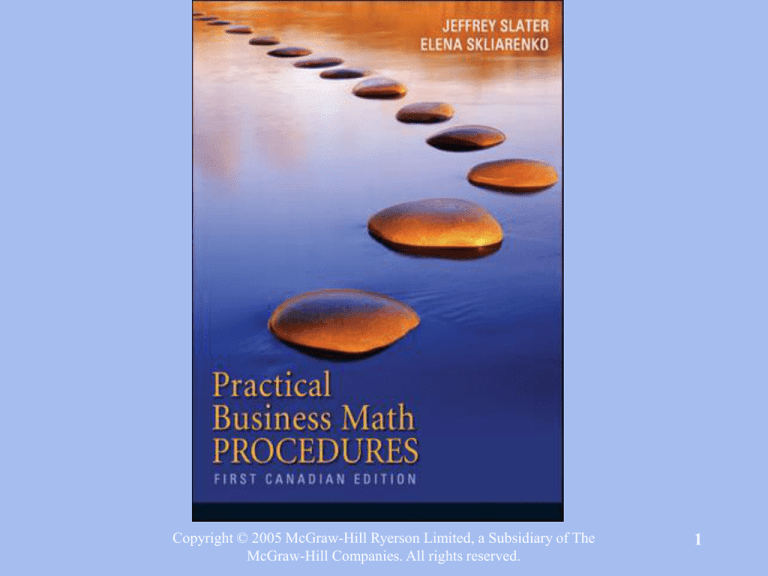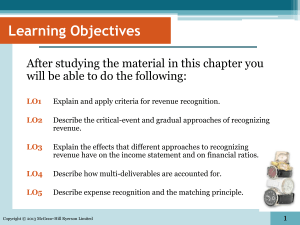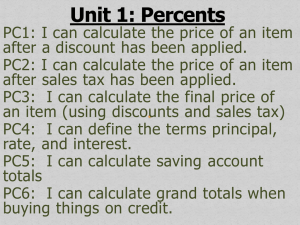
Copyright © 2005 McGraw-Hill Ryerson Limited, a Subsidiary of The
McGraw-Hill Companies. All rights reserved.
1
Chapter 9
Discounts: Trade and
Cash
Prepared by Dr. Elena Skliarenko
Copyright © 2005 McGraw-Hill Ryerson Limited, a Subsidiary of The
McGraw-Hill Companies. All rights reserved.
2
#9
Discounts: Trade and Cash
LU9.1
Learning Unit Objectives
Trade Discounts -- Single and Chain
•
Calculate single trade discounts with formulas and
complements
•
Explain the freight terms FOB shipping point and
FOB destination
•
Find list price when net price and trade discount rate
are known
•
Calculate chain discounts with the net price
equivalent rate and single equivalent discount rate
Copyright © 2005 McGraw-Hill Ryerson Limited, a Subsidiary of The
McGraw-Hill Companies. All rights reserved.
3
#9
LU9.2
Discounts: Trade and Cash
Learning Unit Objectives
Cash Discounts, Credit Terms, and
Partial Payments
•
List and explain typical discount periods and
credit periods that a business may offer
•
Calculate outstanding balance for partial
payments
Copyright © 2005 McGraw-Hill Ryerson Limited, a Subsidiary of The
McGraw-Hill Companies. All rights reserved.
4
THE DISTRIBUTION CHAIN
Manufacturer
Retailer
Distributor
Wholesaler
Final Customer
Copyright © 2005 McGraw-Hill Ryerson Limited, a Subsidiary of The
McGraw-Hill Companies. All rights reserved.
5
Trade Discount Amount & Net Price
Formulas
Trade discount amount = List
price x Trade discount rate
Net Price = List price - Trade
discount amount
Copyright © 2005 McGraw-Hill Ryerson Limited, a Subsidiary of The
McGraw-Hill Companies. All rights reserved.
6
Freight Terms
FOB Shipping Point - buyer pays the freight cost
FOB Quebec - The buyer in Ontario pays the freight
b
u
y
e
r
FOB Destination - seller pays the freight cost
FOB Toronto - The seller in Montreal pays
the freight
Copyright © 2005 McGraw-Hill Ryerson Limited, a Subsidiary of The
McGraw-Hill Companies. All rights reserved.
7
Complement
Complement - The
difference between
the discount rate and
100%
Complement
75%
25%
If the trade discount
is 25%, the
complement is 75%
(100%-25%)
Trade
Discount
Copyright © 2005 McGraw-Hill Ryerson Limited, a Subsidiary of The
McGraw-Hill Companies. All rights reserved.
8
Single Trade Discount
30%
The price of office equipment is
$3,000. The manufacturer
offers a 30% trade discount.
What are the trade discount
amount (TDA) and the net
price?
TDA = $3,000 x .30 = $900
Net Price = $3,000 - $900 = $2,100
Using Complement
$3,000 x .70 = $2,100
Copyright © 2005 McGraw-Hill Ryerson Limited, a Subsidiary of The
McGraw-Hill Companies. All rights reserved.
9
Calculating List Price When Net Price
and Trade Discount Rate Are Known
List Price =
Net Price
.
Complement of trade discount rate
Office equipment has a
$2,100 net price and a
30% trade discount. What
is the list price?
100% - 30% = 70%
$2,100
.70
LP = $3,000
Copyright © 2005 McGraw-Hill Ryerson Limited, a Subsidiary of The
McGraw-Hill Companies. All rights reserved.
10
Short Cut Formulas
To find amount of trade discount Dt, when list price and discount rate are given use
formula 9.1
Dt = L ·d
(9.1)
Substitute the known values and get the amount of Dt.
Dt = 2,700 · 0.4 = $1,080
To find the net price when the list price, amount of discount and discount rate are
given, use one of the two formulas: 9.2 or 9.3
N = L - Dt
(9.2)
or
N = L ( 1-d)
(9.3)
Copyright © 2005 McGraw-Hill Ryerson Limited, a Subsidiary of The
McGraw-Hill Companies. All rights reserved.
11
Chain Discounts
Two or more discounts:
15/10/5
To calculate discount
15 + 10 + 5 = 30%
Find the net price equivalent rate
(multiply the complements)
100% 100% 100%
-15
-10
-5
.85 x .90 x .95 = .72675
Copyright © 2005 McGraw-Hill Ryerson Limited, a Subsidiary of The
McGraw-Hill Companies. All rights reserved.
12
Chain Discounts
The price of office
furniture is $20,000.
With a chain discount of
20/10/5, what is the net
price?
Find the net price equivalent rate
(multiply the complements)
.80 x .90 x .95 = .684
$20,000 x .684 = $13,680
Trade Discount Amount
$20,000 - $13,680 = $6,320
or find single equivalent rate
1.00 - .684 - .316
$20,000 x .316 = $6,320
Copyright © 2005 McGraw-Hill Ryerson Limited, a Subsidiary of The
McGraw-Hill Companies. All rights reserved.
13
Short Cut Formulas
There is a quicker way to calculate the net price after
multiple discounts. For this purpose we can use formula 9.3
with (1-d) factor for each of the discounts.
N = L (1-d1) (1-d2) (1-d3)
(9.5)
Copyright © 2005 McGraw-Hill Ryerson Limited, a Subsidiary of The
McGraw-Hill Companies. All rights reserved.
14
Short Cut formulas
There is a shortcut way to find single equivalent discount rate. For this
purpose use formula 9.6:
de = 1- (1-d1) (1-d2) (1-d3),
(9.6)
where de is a single equivalent to discount rate.
To find amount of the trade discount with series discounts we can use
formula 9.7
Dt = L · de
(9.7)
Copyright © 2005 McGraw-Hill Ryerson Limited, a Subsidiary of The
McGraw-Hill Companies. All rights reserved.
15
Cash Discounts
Discount for prompt payment. Not taken on freight,
returned goods, sales tax, & trade discounts.
Credit Period
Mar. 1
Mar. 31
Time period sellers give buyers to pay invoices
Discount Period
Mar. 1
Mar. 10
Time period buyer has to take advantage of cash discount
Copyright © 2005 McGraw-Hill Ryerson Limited, a Subsidiary of The
McGraw-Hill Companies. All rights reserved.
16
Exact-days-in-a-year calendar
Day of
month
1
2
3
4
5
6
7
8
9
10
11
12
13
14
15
16
17
18
19
20
21
22
23
24
25
26
27
28
29
30
31
31
Jan.
1
2
3
4
5
6
7
8
9
10
11
12
13
14
15
16
17
18
19
20
21
22
23
24
25
26
27
28
29
30
31
28
Feb.
32
33
34
35
36
37
38
39
40
41
42
43
44
45
46
47
48
49
50
51
52
53
54
55
56
57
58
59
-
31
Mar
60
61
62
63
64
65
66
67
68
69
70
71
72
73
74
75
76
77
78
79
80
81
82
83
84
85
86
87
88
89
90
30
Apr
91
92
93
94
95
96
97
98
99
100
101
102
103
104
105
106
107
108
109
110
111
112
113
114
115
116
117
118
119
120
-
31
May
121
122
123
124
125
126
127
128
129
130
131
132
133
134
135
136
137
138
139
140
141
142
143
144
145
146
147
148
149
150
151
30
Jun
152
153
154
155
156
157
158
159
160
161
162
163
164
165
166
167
168
169
170
171
172
173
174
175
176
177
178
179
180
181
-
31
Jul
182
183
184
185
186
187
188
189
190
191
192
193
194
195
196
197
198
199
200
201
202
203
204
205
206
207
208
209
210
211
212
31
Aug
213
214
215
216
217
218
219
220
221
222
223
224
225
226
227
228
229
230
231
232
233
234
235
236
237
238
239
240
241
242
243
30
Sep
244
245
246
247
248
249
250
251
252
253
254
255
256
257
258
259
260
261
262
263
264
265
266
267
268
269
270
271
272
273
-
Copyright © 2005 McGraw-Hill Ryerson Limited, a Subsidiary of The
McGraw-Hill Companies. All rights reserved.
31
Oct
274
275
276
277
278
279
280
281
282
283
284
285
286
287
288
289
290
291
292
293
294
295
296
297
298
299
300
301
302
303
304
30
Nov
305
306
307
308
309
310
311
312
313
314
315
316
317
318
319
320
321
322
323
324
325
326
327
328
329
330
331
332
333
334
-
17
31
Dec
335
336
337
338
339
340
341
342
343
344
345
346
347
348
349
350
351
352
353
354
355
356
357
358
359
360
361
362
363
364
365
Ordinary Dating Method
2/10, n/30 - “two ten, net thirty”
$500 invoice dated May 3; terms
2/10, n/30; paid on May 10.
$500 x.02 = $10
$500 - $10 = $490
or
$500 x .98 = $490
Discount Period
10 Days
May 3
No Discount
Day 11 - 30
May 13
June2
Credit Period (30 days)
Copyright © 2005 McGraw-Hill Ryerson Limited, a Subsidiary of The
McGraw-Hill Companies. All rights reserved.
18
Receipt of Goods (ROG)
1/10, n/30 ROG - Cash discount period begins
when the buyer receives the goods
$1,000 x.01 = $10
$1,000 invoice dated May 5, received
goods June 7; terms 1/10, n/60 ROG;
paid on June 17.
$1,000 - $10 = $990
or
$1,000 x .99 = $990
Invoice
Date
May 5
Discount Period
10 Days
June 7
No Discount
Day 11 - 30
June
17
Aug.
6
Credit Period (30 days)
Copyright © 2005 McGraw-Hill Ryerson Limited, a Subsidiary of The
McGraw-Hill Companies. All rights reserved.
19
End of Month (EOM)
2/10 EOM - 2% discount, up until the 10th of the
following month
$400 invoice dated Sept. 3; terms 2/10
$400 x .02 = $8
EOM; paid on October 8.
$400 - $8 = $392
or
Invoice
Date
Sept.3
Discount Period
10 Days
Oct 1
No Discount
Day 11 - 30
Oct. 10
$400 x .98 = $392
Oct. 30
Credit Period
Copyright © 2005 McGraw-Hill Ryerson Limited, a Subsidiary of The
McGraw-Hill Companies. All rights reserved.
20
End of Month (EOM)
2/10 EOM - Consider the “25th rule” - Skip
a month
$400 invoice dated Sept. 28; terms 2/10
EOM; paid on November 8.
$400 x .02 = $8
$400 - $8 = $392
or
$400 x .98 = $392
Invoice
Date
Sept.28
Discount Period
10 Days
No.v 1
No Discount
Day 11 - 30
Nov. 10
Nov. 30
Credit Period
Copyright © 2005 McGraw-Hill Ryerson Limited, a Subsidiary of The
McGraw-Hill Companies. All rights reserved.
21
Partial Payment
• Sara owes $400. Sara’s terms were 3/10, n/30. Within 10
days Sara sent in a payment of $100. How much is her
new balance?
100% - 3% = .97
1. Find the
complement of
discount rate
$100
.97 = $103.09
2. Divide partial
payment by the
complement
$400 - $103.09 =
$296.91
Copyright © 2005 McGraw-Hill Ryerson Limited, a Subsidiary of The
McGraw-Hill Companies. All rights reserved.
3. Subtract step
2 from the
amount owed
22
Short Cut Formulas
Amounts credited (Cr) to customer’s account will be bigger than the
amounts paid and may be calculated by formula 9.8:
Amount Credited = Amount Paid
(9.8)
P (1-d)
Cr
(1 d )
Amounts paid within the discount period will be smaller than amounts
credited to the customer’s account and can be calculated by formula 9.9:
P = Cr · (1-d)
(9.9)
Outstanding balance is the difference between the balance at the
beginning of the transaction Bi and the amount credited.
Bo = Bi – Cr
(9.10)
Copyright © 2005 McGraw-Hill Ryerson Limited, a Subsidiary of The
McGraw-Hill Companies. All rights reserved.
23








